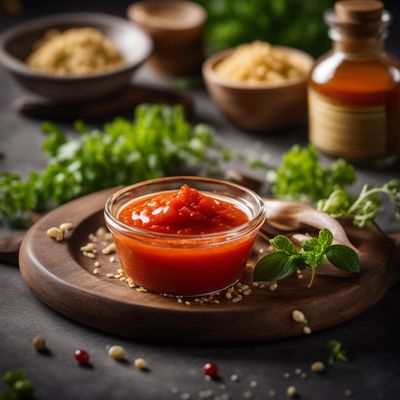
Ingredient
Condiments (including table-top formats)
The Flavor Enhancers: Unleashing the Power of Condiments
Condiments come in a wide variety of forms, including sauces, spreads, and seasonings. They are typically used to enhance the flavor of dishes, adding a burst of tanginess, spiciness, or sweetness. Whether it's a dollop of ketchup on a burger or a drizzle of soy sauce on sushi, condiments play a crucial role in elevating the taste of food. They can be made from a combination of herbs, spices, fruits, vegetables, and other ingredients, resulting in a diverse range of flavors and textures.
Origins and history
Condiments have been an integral part of human cuisine for centuries. The use of condiments dates back to ancient civilizations, where they were used to preserve food, enhance flavor, and add medicinal properties. Throughout history, condiments have evolved and adapted to different cultures and cuisines, becoming an essential component of dishes around the world. From the mustard of ancient Rome to the soy sauce of East Asia, condiments have played a significant role in shaping culinary traditions.
Nutritional information
Condiments can provide a range of nutritional benefits, depending on their ingredients. Some condiments, like mustard and hot sauce, are low in calories and fat, while others, like mayonnaise and ketchup, may contain higher amounts of fat and sugar. It's important to read the nutrition labels and use condiments in moderation to maintain a balanced diet.
Allergens
Some condiments may contain allergens such as gluten, soy, eggs, or nuts. It's crucial to check the ingredient list and allergen information before consuming condiments, especially if you have food allergies or intolerances.
How to select
When selecting condiments, look for products that are made with high-quality ingredients and have minimal additives or preservatives. Opt for condiments that have a fresh and vibrant color, as this can indicate the use of fresh ingredients. Additionally, check the expiration date to ensure freshness and quality.
Storage recommendations
To maintain the freshness and quality of condiments, store them in a cool, dry place away from direct sunlight. Some condiments, like ketchup and mustard, can be stored in the refrigerator to prolong their shelf life. It's important to tightly seal the containers to prevent air and moisture from entering, which can lead to spoilage.
How to produce
Condiments can be produced at home by combining various ingredients and flavors. Experiment with different herbs, spices, fruits, and vegetables to create your own unique condiments. Follow recipes or try your own combinations to achieve the desired taste and texture.
Preparation tips
Condiments can be used in a variety of ways, depending on the specific condiment and the dish being prepared. They can be used as a dipping sauce, a marinade, a dressing, or a topping. Experiment with different combinations and quantities to find the perfect balance of flavors for your dishes.
Culinary uses
Condiments are widely used in cuisines around the world. They can be found in dishes from various cultures, including American, Asian, European, and Middle Eastern cuisines. From the spicy sriracha of Thailand to the tangy salsa of Mexico, condiments add a unique touch to each culinary tradition.
Availability
Condiments are available in grocery stores, supermarkets, and specialty food stores worldwide. They can also be purchased online, making it easy to access a wide variety of condiments from different regions and cultures.




